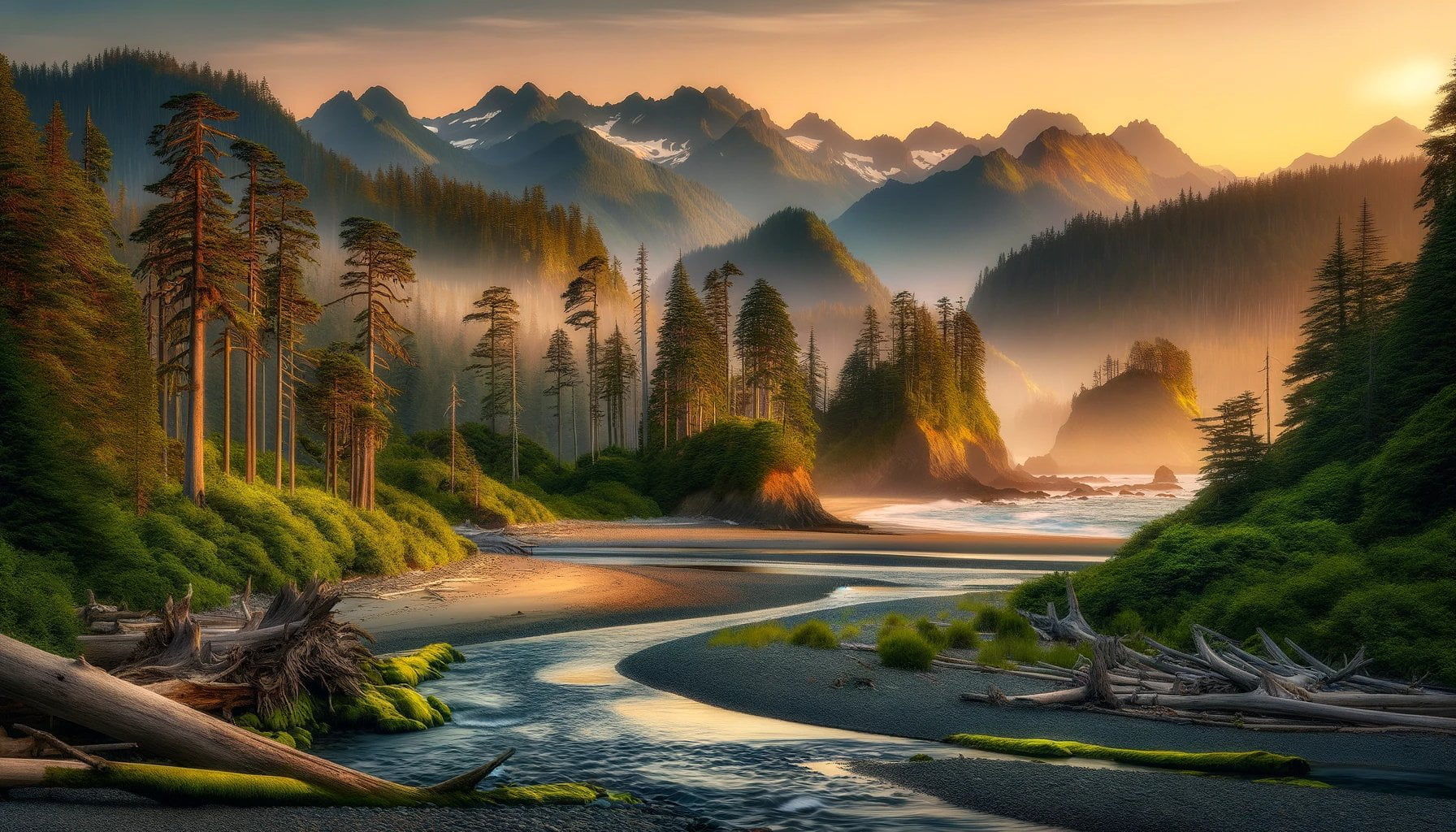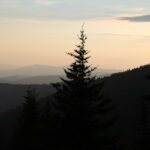Discover Fascinating Fun Facts about Olympic National Park. Immerse yourself in the wonders of nature as we unveil intriguing tidbits about one of America’s most breathtaking national parks. From its stunning geography to its diverse flora and fauna, Olympic National Park has endless stories waiting to be told. Join us on a journey of discovery as we delve into the captivating and awe-inspiring world of this natural wonder. Get ready to be amazed by the unique features and extraordinary experiences that await in Olympic National Park!

Key Takeaways:
- Olympic National Park spans over 876,447 acres, with 95% of it designated as wilderness.
- The park offers 611 miles of hiking trails for visitors to explore its diverse landscapes.
- It is one of the few places on Earth where glaciers exist at a low elevation, with 60 named glaciers in the park.
- Olympic National Park showcases the rich history of the region through over 650 archeological sites.
- Visitors can enjoy over 3,000 miles of rivers and streams for fishing and water activities.
- The park boasts 73 miles of Pacific Ocean coastline, perfect for beachcombing and tidepooling.
- It is home to at least 22 federally listed Threatened or Endangered Species.
- Olympic National Park has 16 kinds of endemic animals and 8 kinds of endemic plants, highlighting its unique ecological significance.
- There are 130 historical structures within the park, providing insight into the area’s cultural heritage.
- The park harbors over 1,200 native plant taxa, making it a haven for nature enthusiasts.
Fun Facts about Olympic National Park
Olympic National Park is a treasure trove of fascinating facts and natural wonders. This majestic park covers over 876,447 acres, with an impressive 95% designated as wilderness. Its expansive landscapes and diverse ecosystems offer endless opportunities for exploration and discovery.
Hiking Trails and Glaciers
One of the most remarkable aspects of Olympic National Park is its extensive network of 611 miles of hiking trails. Whether you’re a novice hiker or an experienced backpacker, these trails cater to all skill levels and provide breathtaking views of the park’s stunning scenery.
It is incredible to note that Olympic National Park is one of the few places on Earth where glaciers exist at a low elevation. With a staggering 60 named glaciers within its boundaries, visitors can witness these frozen marvels up close and appreciate their unique presence in this remarkable landscape.
Archeological Sites and Rivers
Olympic National Park is not just a haven for nature lovers; it also holds a rich history within its boundaries. More than 650 archeological sites can be found in the park, showcasing the diverse cultures that have inhabited the region throughout the centuries. Exploring these sites offers a glimpse into the past and an appreciation for the area’s cultural heritage.
For those who enjoy water activities, Olympic National Park doesn’t disappoint. With over 3,000 miles of rivers and streams, fishing and other water-based recreation thrive here. Whether you’re casting a line or simply enjoying the serene beauty of these waterways, the park offers abundant opportunities to connect with nature.
Pacific Ocean Coastline and Wildlife
Imagine the delight of experiencing a national park that includes a 73-mile Pacific Ocean coastline. Olympic National Park’s diverse landscapes extend to the shoreline, providing stunning beaches and unique opportunities for beachcombing and tidepooling. The rhythmic crashing of waves against the rugged cliffs creates a mesmerizing backdrop for nature enthusiasts to immerse themselves in.
The park’s biodiversity also shines through its remarkable wildlife. With at least 22 federally listed Threatened or Endangered Species calling Olympic National Park home, visitors have a chance to observe these rare creatures in their natural habitat. Additionally, the park boasts 16 kinds of endemic animals and 8 kinds of endemic plants, further highlighting its ecological significance and the importance of preserving this precious ecosystem.
Historical Structures and Native Plants
Olympic National Park preserves not only its natural wonders but also its historical structures. Within its boundaries, you can find 130 historical structures that provide valuable insights into the region’s cultural heritage. From old homesteads to notable buildings, these structures serve as a reminder of the area’s past and the people who have shaped its history.
Delving into the flora of Olympic National Park is an adventure of its own. With over 1,200 native plant taxa, the park showcases an extraordinary array of floral diversity. Exploring the varied ecosystems within the park, from lowland forests to alpine meadows, reveals an enchanting tapestry of colors and fragrances, displaying the wonders of nature at its finest.
In conclusion, Olympic National Park is a captivating natural wonder that enthralls visitors with its awe-inspiring features and remarkable fun facts. From its extensive hiking trails and glaciers to its archeological sites and diverse wildlife, this park offers endless opportunities for exploration and discovery. With its rich history, stunning coastline, and remarkable array of native plants, Olympic National Park truly deserves its place among the most remarkable national parks in the United States.
Sources:
1. Visiting Olympic National Park: The Complete Guide
2. Your Complete Guide to Olympic National Park
Here are some fascinating facts to expand your knowledge:
1. Did you know there are 25 surprising facts about the Pentagon? Find out more by clicking here.
- Discover the cool and unknown facts about the Dominican Republic that will leave you amazed! Uncover them here.
- Have you ever wondered about the remarkable facts surrounding the Suez Canal? Learn about them in depth by clicking here.
- Prepare for an exciting journey through the interesting facts about Bora Bora! Get ready for the adventure by clicking here.
- Dive into the history with astonishing facts about the Temple of Artemis. Explore them here.
- Get ready to be captivated by the intriguing facts about the River Jordan. Discover them here.
- Take a leap into the extraordinary and learn fascinating facts about the New River Gorge Bridge. Don’t miss out, click here to uncover them.
- Unveil the top 10 facts that make Key West an exceptional destination! Start your exploration here.
- Get ready to be dazzled by 3 interesting facts about the Dominican Republic that will amaze you. Begin your journey by clicking here.
- Travel through the North Central Plains of Texas with fun facts that will surprise you. Discover them all here.
Expand your knowledge and dive into these intriguing facts by clicking on the links above. Happy exploring!
The Diverse Flora and Fauna of Olympic National Park
The breathtaking beauty of Olympic National Park extends beyond its stunning landscapes. This national park is a haven for diverse flora and fauna, with an incredible array of plant and animal species that call this natural wonderland home. Let’s delve into the fascinating world of the flora and fauna of Olympic National Park.
An Abundance of Plant Life
Olympic National Park boasts over 1,100 plant species, showcasing the incredible biodiversity of the Olympic Peninsula [^1^][^2^]. From towering conifers to delicate wildflowers, the park’s diverse vegetation creates an enchanting tapestry of colors and textures. You’ll encounter ancient moss-draped trees, lush ferns, and vibrant blooms as you explore the park’s diverse ecosystems.
Endemic Species and Unique Wildlife
One of the park’s standout features is its endemic species, which are found exclusively within its boundaries. For instance, the Olympic marmot, with its endearing appearance, is a charming resident of the park [^1^]. This unique species is a testament to the park’s commitment to preserving the natural habitat of its inhabitants.
Olympic National Park is also home to an array of wildlife. From majestic elk and black bears to agile mountain goats, the park offers sightings of both iconic and lesser-known creatures. Bird enthusiasts will be delighted by the park’s feathered inhabitants, including the elusive spotted owl and the magnificent bald eagle [^1^].
A Tapestry of Ecosystems
What sets Olympic National Park apart is its exceptionally diverse ecosystems. Within its expansive boundaries, you’ll find alpine mountains, temperate rainforests, and awe-inspiring coastlines [^1^]. Each ecosystem harbors a unique set of flora and fauna, creating an enchanting tapestry of life.
Preserving Fragile Habitats
With over 95% of the park designated as wilderness, Olympic National Park is committed to preserving its fragile habitats [^1^]. This designation ensures that the diverse flora and fauna can thrive undisturbed for generations to come. The park’s dedication to conservation creates a sanctuary for both common and endangered species.
Threats to the Ecosystem
Unfortunately, Olympic National Park faces numerous threats to its delicate ecosystems and wildlife. Climate change, habitat loss, and invasive species pose significant challenges [^4^]. Recognizing these threats is vital in implementing measures to protect the park’s precious flora and fauna, ensuring their survival for future generations to appreciate.
Immersion in Nature’s Wonders
As you explore Olympic National Park, immerse yourself in the wonders of its diverse flora and fauna. Hike through towering forests, breathing in the crisp air scented with pine and wildflowers. Keep your eyes peeled for native plant species, delicate blooms, and elusive wildlife. Discover the interconnectedness of these natural wonders, and gain a deeper appreciation for the delicate balance of life within the park.
Key Takeaways:
- Olympic National Park is home to over 1,100 plant species, showcasing its incredible biodiversity [^1^][^2^].
- The park harbors endemic species like the Olympic marmot, which are found exclusively within its boundaries [^1^].
- Diverse ecosystems within the park, including alpine mountains, temperate rainforests, and breathtaking coastlines, house a rich variety of flora and fauna [^1^].
- Conservation efforts and the park’s wilderness designation ensure the preservation of fragile habitats and the thriving of diverse species [^1^].
- Threats such as climate change, habitat loss, and invasive species pose challenges to the park’s ecosystems and wildlife [^4^].
Sources:
1. AZ Animals – Incredible Facts About Olympic National Park
2. National Park Service – Plants of Olympic National Park
Interesting Features and Attractions in Olympic National Park
Key Takeaways:
– Olympic National Park spans over 876,447 acres and is predominantly designated as wilderness, offering a vast expanse of untouched natural beauty.
– With 611 miles of hiking trails, the park provides ample opportunities for exploration and discovery of its diverse landscapes, from mountains to rainforests to coastlines.
– The park boasts 60 named glaciers, making it one of the few places on Earth where glaciers exist at low elevations.
– Olympic National Park is a treasure trove of archaeological sites, with over 650 sites providing valuable insight into the region’s rich cultural history.
– Visitors can immerse themselves in the park’s history through its 130 historical structures, which offer a glimpse into the past.
– The park’s abundant rivers and streams, covering over 3,000 miles, create a haven for fishing and water-based recreation.
– Olympic National Park’s 73-mile Pacific Ocean coastline is a breathtaking sight, featuring stunning beaches and rugged cliffs.
– The park is home to a remarkable array of endemic species, with at least 16 kinds of endemic animals and 8 kinds of endemic plants, contributing to its unique and important ecosystem.
– Wildlife enthusiasts will be delighted to know that Olympic National Park supports a diverse range of wildlife, including 22 species of federally listed threatened or endangered species.
– Outdoor enthusiasts can indulge in a variety of activities such as hiking, camping, wildlife viewing, and photography, making Olympic National Park the perfect destination for adventure seekers.
– Cultural enthusiasts can explore numerous cultural sites within the park, providing an opportunity to learn about the rich heritage of the region.
– With over 1,200 species of native plants, the park’s ecological significance is undeniable.
Olympic National Park is a nature lover’s paradise, offering an array of interesting and awe-inspiring features and attractions. Spanning over a vast area of 876,447 acres, with 95% designated as wilderness, this park showcases the true essence of untouched natural beauty. Its 611 miles of hiking trails weave through diverse landscapes, beckoning adventurers to explore its mountains, rainforests, and coastlines.
One fascinating feature of Olympic National Park is its 60 named glaciers. These icy wonders are a rare sight, as few places on Earth have glaciers at low elevations. These glaciers not only add to the park’s captivating beauty but also contribute to its unique ecosystem.
For history enthusiasts, Olympic National Park is a treasure trove of archaeological sites. With over 650 sites scattered throughout the park, these sites provide valuable insight into the region’s rich cultural history. Additionally, the park preserves 130 historical structures, allowing visitors to step back in time and experience a glimpse of the past.
Water lovers will find plenty to indulge in with over 3,000 miles of rivers and streams flowing through Olympic National Park. Whether it’s fishing or engaging in water-based recreational activities, the park offers endless possibilities.
The park’s 73-mile Pacific Ocean coastline is another captivating feature, boasting stunning beaches and rugged cliffs. The crashing waves and picturesque vistas create a truly unforgettable experience.
One of Olympic National Park’s greatest assets is its diverse array of wildlife. With at least 16 kinds of endemic animals and 8 kinds of endemic plants, the park is a haven for species unique to the area. Additionally, the park supports a multitude of wildlife, with 22 species listed as federally threatened or endangered.
For adventure seekers, Olympic National Park offers a range of outdoor activities, including hiking, camping, wildlife viewing, and photography. The diverse landscapes and abundance of wildlife provide endless opportunities for exploration and discovery.
Cultural enthusiasts will also find delight in the numerous cultural sites within the park. These sites offer a chance to delve into the rich heritage of the region and learn about the traditions and history that make Olympic National Park so unique.
With over 1,200 species of native plants, Olympic National Park holds great ecological significance. The park’s lush flora adds to its overall beauty and serves as a testament to its thriving ecosystem.
In conclusion, Olympic National Park is a treasure trove of interesting features and attractions. From its expansive wilderness to its glaciers, archaeological sites, and diverse wildlife, the park offers an unforgettable experience for nature enthusiasts, adventure seekers, and cultural enthusiasts alike.
To learn more about Olympic National Park and plan a visit, please refer to the following sources:
- National Park Obsessed, “Visiting Olympic National Park: The Complete Guide.” Available at: Visiting Olympic National Park: The Complete Guide
- Let’s Roam, “Your Complete Guide to Olympic National Park.” Available at: Your Complete Guide to Olympic National Park
The Conservation Efforts and Future of Olympic National Park
Key Takeaways:
– Olympic National Park covers over 876,447 acres, with 95% designated as wilderness.
– The park has diverse ecosystems, including mountains, rainforests, and coastlines.
– Conservation efforts and wilderness designation protect the park’s habitats and species.
– Threats to the park include climate change, habitat loss, and invasive species.
Olympic National Park, with its vast wilderness and diverse ecosystems, is not only a stunning natural wonder but also a place of significant conservation efforts. With 95% of its landscape designated as wilderness, the park serves as a haven for protecting the country’s wildlands.
Conservation efforts play a crucial role in safeguarding the park’s habitats and species. The park’s management focuses on preserving the delicate balance of its three major ecosystems: the coastline, temperate rainforest, and alpine meadows. By actively managing these areas and implementing measures to reduce human impact, Olympic National Park aims to ensure the long-term sustainability of its biodiversity.
Despite these efforts, the park faces several challenges that threaten its future. One of the most pressing concerns is climate change, which poses a significant risk to the park’s glaciers, ecosystems, and wildlife. Rising temperatures can lead to the loss of glaciers, affecting the water resources they provide and disrupting the delicate balance of the park’s ecosystems.
Habitat loss is another grave threat to Olympic National Park. As human activities expand, the encroachment on natural habitats disrupts the park’s delicate ecosystems and threatens the survival of its diverse plant and animal species.
Additionally, invasive species pose a significant challenge to the park’s native flora and fauna. These non-native species can outcompete and displace native species, leading to an imbalance in the park’s biodiversity. Efforts to prevent the spread of invasive species and control their populations are essential for maintaining the park’s ecological integrity.
Despite these challenges, Olympic National Park remains committed to its conservation mission. By working closely with researchers, conservation organizations, and local communities, the park continues to develop strategies and initiatives to mitigate the threats it faces.
The future of Olympic National Park relies on the shared responsibility of visitors, local communities, and policymakers to protect and preserve this natural treasure. By promoting sustainable practices, supporting conservation efforts, and raising awareness about the importance of protecting national parks, we can ensure that future generations get to experience the incredible beauty and biodiversity of Olympic National Park.
Sources:
– National Parks Conservation Association – Olympic National Park
– Treehugger – 10 Facts About Olympic National Park

FAQ
Q1: How large is Olympic National Park?
A1: Olympic National Park spans over 876,447 acres, making it one of the largest wilderness areas in the contiguous United States.
Q2: How many miles of hiking trails are there in Olympic National Park?
A2: Olympic National Park features a network of 611 miles of hiking trails, providing ample opportunities for visitors to explore its diverse landscapes.
Q3: How many glaciers are there in Olympic National Park?
A3: Olympic National Park is home to 60 named glaciers, making it one of the few places on Earth where glaciers exist at low elevations.
Q4: What can visitors explore in Olympic National Park besides nature?
A4: Besides nature, visitors to Olympic National Park can explore over 650 archaeological sites, providing insight into the rich cultural history of the region, as well as 130 historical structures that offer a glimpse into the past.
Q5: What wildlife can be found in Olympic National Park?
A5: Olympic National Park is known for its diverse wildlife, with at least 22 federally listed Threatened or Endangered Species living in the park. Additionally, the park is home to 16 kinds of endemic animals, highlighting its unique ecological significance.
- Star Ring Trends: Etsy vs Amazon - March 28, 2025
- Boost Pollinator Habitats: Baby Blue Eyes Sustainable Farming Guide - March 28, 2025
- Protect Big Black Bears: Effective Conservation Strategies - March 28, 2025
















